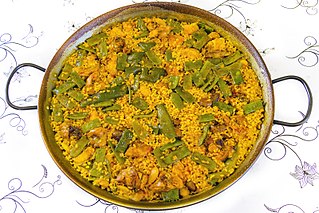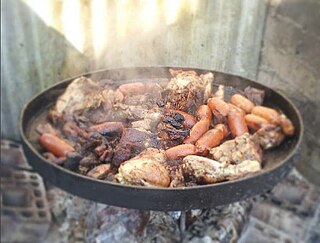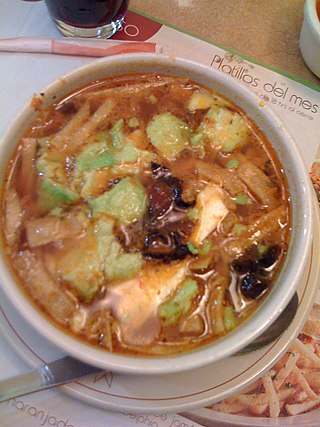
Paella is a rice dish originally from the Valencian Community. Paella is regarded as one of the community's identifying symbols. It is one of the best-known dishes in Spanish cuisine.

Fried rice is a dish of cooked rice that has been stir-fried in a wok or a frying pan and is usually mixed with other ingredients such as eggs, vegetables, seafood, or meat. It is often eaten by itself or as an accompaniment to another dish. Fried rice is a popular component of East Asian, Southeast Asian and certain South Asian cuisines, as well as a staple national dish of Indonesia. As a homemade dish, fried rice is typically made with ingredients left over from other dishes, leading to countless variations. Fried rice first developed during the Sui Dynasty in China.

Mexican rice, also known as arroz a la mexicana, arroz mexicano, sopa de arroz, or arroz rojo in Spanish, is a Mexican side dish made from white rice, tomato, garlic, onion, and perhaps other ingredients. Mexican rice is almost always eaten as a complement to other dishes such as mole, refried beans, rotisserie chicken, carne asada, picadillo, tacos, fried fish, fried chicken, chiles rellenos, or vegetable soup.

Arròs negre is a Valencian and Catalan dish made with cuttlefish and rice, somewhat similar to seafood paella. Some call it paella negra, although it is traditionally not called a paella even though it is prepared in a similar manner.

Rajas con crema is the name given to a Mexican dish consisting of sliced poblano pepper with cream. It is very popular in Mexico, particularly in the central and southern parts of the country. It is one of the dishes most commonly served during taquizas, together with tinga, mole, chicharrón, and papas con chorizo. Preparation of the dish involves roasting, peeling and slicing the peppers, sauteing them together with sliced onions, and simmering the mixture with cream. Sometimes chicken broth is added for flavor.

Picadillo is a traditional dish in many Latin American countries including Puerto Rico and Cuba as well as the Philippines. It is made with ground meat, tomatoes, and also raisins, olives, and other ingredients that vary by region. It is often served with rice or used as a filling in dishes such as tacos, savory pastries or croquettes. The name comes from the Spanish word picar, meaning "to mince".

Dominican cuisine is made up of Spanish, indigenous Taíno, Middle Eastern and African influences. The most recent influences in Dominican cuisine are from the British West Indies and China.

Arroz a la valenciana or Valencian rice is a name for a multitude of rice dishes from diverse cuisines of the world, which originate from the rice-cooking tradition of the Valencian Community, in eastern Spain.

Most traditional foods in Guatemalan cuisine are based on Maya cuisine, with Spanish influence, and prominently feature corn, chilies and beans as key ingredients. Guatemala is famously home to the Hass avocado.

Venetian cuisine, from the city of Venice, Italy or more widely from the region of Veneto, has a centuries-long history and differs significantly from other cuisines of northern Italy, and of neighbouring Austria and of Slavic countries, despite sharing some commonalities.

Arroz con gandules is a combination of rice, pigeon peas, and pork, cooked in the same pot with sofrito. This is Puerto Rico's national dish along with roasted pork.

Discada is a mixed meat dish popular in the northern Mexican cuisine. The dish includes a mixture of grilled meats cooked on an agricultural plow disk harrow, hence its name. The basic meats for a traditional discada include beef, bacon, ham, sausage, and Mexican chorizo. The disk is placed over an open flame, and the ingredients are introduced one at a time. The meats are seasoned and marinated according to the cook's preference and usually include salt, pepper, lime juice, and garlic. Aromatics including white or purple onions, bell peppers, Jalapeno or Serrano peppers, olives, and tomatoes are also used to add flavor and color to the dish. It is usually served with tortillas in tacos or separately on a plate.

Oaxacan cuisine is a regional cuisine of Mexico, centered on the city of Oaxaca, the capital of the eponymous state located in southern Mexico. Oaxaca is one of Mexico's major gastronomic, historical, and gastro-historical centers whose cuisine is known internationally. Like the rest of Mexican cuisine, Oaxacan food is based on staples such as corn, beans and chile peppers, but there is a great variety of other ingredients and food preparations due to the influence of the state's varied geography and indigenous cultures. Corn and many beans were first cultivated in Oaxaca. Well known features of the cuisine include ingredients such as chocolate, Oaxaca cheese, mezcal and grasshoppers (chapulines) with dishes such as tlayudas, Oaxacan style tamales and seven notable varieties of mole sauce. The cuisine has been praised and promoted by food experts such as Diana Kennedy and Rick Bayless and is part of the state's appeal for tourists.

The cuisine of Veracruz is the regional cooking centered on the Mexican state that stretches over most of the country's coast on the Gulf of Mexico. Its cooking is characterized by three main influences, indigenous, Spanish and Afro-Cuban, due to its history, which included the arrival of the Spanish and that of slaves from Africa and the Caribbean. These influences have contributed many ingredients to the cooking including native vanilla, corn and seafood, along with rice, spices and tubers. How much the three mix depending on the area of the state, with some areas more heavily favoring one or another. The state has worked to promote its cuisine both in Mexico and abroad as part of its tourism industry.

The cuisine of Chiapas is a style of cooking centered on the Mexican state of the same name. Like the cuisine of rest of the country, it is based on corn with a mix of indigenous and European influences. It distinguishes itself by retaining most of its indigenous heritage, including the use of the chipilín herb in tamales and soups, used nowhere else in Mexico. However, while it does use some chili peppers, including the very hot simojovel, it does not use it as much as other Mexican regional cuisines, preferring slightly sweet seasoning to its main dishes. Large regions of the state are suitable for grazing and the cuisine reflects this with meat, especially beef and the production of cheese. The most important dish is the tamal, with many varieties created through the state as well as dishes such as chanfaina, similar to menudo and sopa de pan. Although it has been promoted by the state of Chiapas for tourism purposes as well as some chefs, it is not as well known as other Mexican cuisine, such as that of neighboring Oaxaca.

Caldo tlalpeño is a chicken and vegetable soup in Mexican cuisine which contains chicken meat, and chickpeas, carrots, and green beans, submerged in a chicken broth with garlic and onion, seasoned with epazote, cumin and chipotle chili. It is served with avocado slices and diced cheese, and accompanied with lime.

Mole verde is a type of mole of the cuisine of Mexico.

Arroz a la tumbada is a traditional Mexican dish prepared with white rice and seafood. In this specialty a sofrito is made with chopped tomato, onion, garlic and red pepper. Rice and fish broth or water is added, then seafood which may include shrimp, clams, crab, calamari and whitefish. The dish may be seasoned with fresh leaves of epazote, parsley, coriander and oregano. Arroz a la tumbada is traditionally cooked in a cazuela, which is a thick clay pot.

Relleno negro is a dish from Yucatán, México, based on turkey, pork and mixed chili peppers (chilmole). It is traditionally prepared in the month of November in a festival called Hanal Pixán.





























